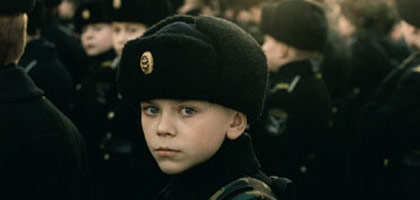Primary navigation


A new documentary sees the Chechen conflict through children's eyes. By Leslie Felperin
Like Hubert Sauper's Darwin's Nightmare, which also premiered at Venice 2004, Finnish film-maker Pirjo Honkasalo's The 3 Rooms of Melancholia is one of the finest documentaries of the past year. Heartbreaking, poetic and willing to take a fearless look at the kind of hard truths most fiction film-makers don't want to face, it meets children in three different corners of the former Soviet Union. A collage of stories and harrowing yet transcendently beautiful images depicts how hearts and minds are shaped to destroy bodies and souls.
Honkasalo explained to me at Amsterdam's documentary festival last November that the film grew from an aborted project to make a decalogue of documentaries based on the Ten Commandments. After the series collapsed she started to think about "how we can let what's going on in Russia happen," she said. "Back in Soviet times we knew they had prison camps, we knew there were dissidents, but we just accepted it was their internal affair. But now they've killed a quarter of a million of their own people and we cannot accept it again. I felt strongly that I was being given a second chance to open my mouth and if I didn't use it I couldn't respect myself."
The first part of the triptych, titled 'Nostalgia' (a nod to Andrei Tarkovsy), takes place at the Kronstadt cadet academy near St Petersburg, where young Russian boys, most of them orphans or from severely underprivileged backgrounds, are trained to become future soldiers. In the beautiful school buildings, erected in the time of Peter the Great, a chilling atmosphere prevails as the lads learn how to load and fire guns, polish shoes and recite poetry by rote. Some of their stories are told in voiceover and Honkasalo adds television footage of the Moscow theatre siege as a reminder of the ongoing but distant war.
In the second part, 'Breathing', we get close to that war as the film-maker and her crew enter a zone that even well-connected journalists often find impossible to penetrate. Digital footage (the rest of the film was shot on 16mm) provides long travelling shots of Chechnya's war-torn capital Grozny, a hellish landscape of barely standing buildings, ravaged civilians and constant gunfire, backed by a mournful score written by avant-garde Finnish composer Sanna Salmenkallio, who uses lines from some of the Kronstadt children's self-penned poetry as refrains. The climax occurs in a derelict apartment block where a Chechen woman named Hadizhai Gatheva comes to take away the distraught children of a dying woman who knows this is her family's only chance.
The final section, 'Remembering', takes place in a refugee camp in Chechnya's neighbouring country of Ingushetia, where Gatheva cares for the children she has rescued. As they tell their stories, often deeply distressing accounts of anguish and abuse at the hands of soldiers and parents, the camera lingers on their blank faces or on scenes around the camp. Viewers sensitive to animal welfare are warned there is explicit footage of a goat being killed for food - though this pales beside the record of human suffering.
"Strangely enough, the structure of the film came before anything else," said Honkasalo. "I always wanted to make a triptych with the Russians on the left, the Chechens on the right and the evil in the middle. I also always knew I wanted to have a musical structure, like a symphony that the audience could build up for themselves. I'm not so crazy about stories because today everything is narrative. And for me all the children here are one character in a way - when you put them all together they are same child."